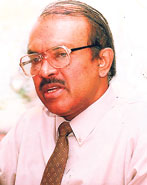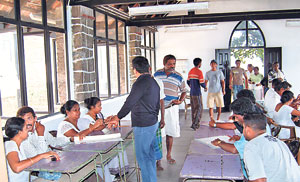Four years after the election of Sri Lanka's fifth President, the country will go to the polls to elect the sixth President.
Although the President is elected for a period of six years, under the Constitution of
Sri Lanka, the incumbent President has the power to call for an election "any time after the expiration of four years from the
commencement of his first term of office, by Proclamation, declare his intention of appealing to the People for a mandate to hold office, by election, for a further term."
President Mahinda Rajapaksa using the
above provision in the Constitution has called for an election immediately after completing four years in office. He will thus seek the people's support for a second term in office.
A President can hold office for only two terms as the Constitution states that "no person who has been twice elected to the office of President by the People shall be qualified thereafter to be elected to such office by the People."
Once the Proclamation is made public, the next step is to call for
nominations, which has been done by the Commissioner of Elections who has the authority to do so. The nomination date was fixed for Thursday December 17, 2009. Nominations were received from 9 – 11 in the morning at the Election Secretariat at Rajagiriya. Another half an hour was allotted to receive any objections.
According to the Constitution, "any citizen who is qualified to be
elected to the office of President may be
nominated as a candidate for such office –
(a) by a recognized
political party, or
(b) if he is or has been an
elected member of
the legislature, by any other political party or by an elector whose name has been entered in any
register of electors."
Although we are used to hearing the names of only a handful of political
parties, the number
registered with the Department of Elections is much more. Right now there are 65 political
parties registered with the Department.
An approved symbol is allocated to each party. Not all parties are active. Apart from the major ones, which is around a dozen at the most, it is only at
election time – Presidential and General – that the names of some of the others are heard.
 |
Commissioner of Elections
Dayananda Dissanayake |
A record number of 22 candidates are contesting this year. This is the
highest number of
candidates to date for a Presidential Election. At the election to be held on Tuesday January 26, 2010, the voters will see the longest ballot paper so far.
At the last Presidential Election held on November 17, 2005, candidates from 13 political parties
submitted nominations. Their symbols ranged from a cricket bat to a trishaw.
Their names along with the political parties they represent and their
symbols were published in a notice under Section 21 of the Presidential Elections Act No. 51 of 1981 by the Commissioner of Elections.
In the previous election too (in 1999), 13 candidates contested.
Candidates have to pay a deposit before they hand over their nominations for the Presidential Election.
Each candidate from a recognised political party has to pay Rs. 50,000 while the amount for the others is Rs. 75,000.
The number of eligible voters has increased from 13,327,160 in 2005 to 14,088,500 recording a
little less than a 2% increase. |


